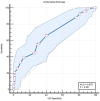Association of endometrial thickness with lesions in postmenopausal asymptomatic women: risk factors and diagnostic thresholds
- PMID: 40057773
- PMCID: PMC11889871
- DOI: 10.1186/s12905-025-03641-2
Association of endometrial thickness with lesions in postmenopausal asymptomatic women: risk factors and diagnostic thresholds
Abstract
Purpose: This study aimed to explore the relationship between endometrial thickness and lesions in asymptomatic postmenopausal women and identify diagnostic thresholds for lesions.
Methods: A total of 279 postmenopausal asymptomatic women aged 40 years or older with endometrial thickness ≥ 4 mm were retrospectively selected in our hospital, from January 2018 to June 2023, there were 33 cases's operations which were failed due to the cervical stenosis, 8cases who used hormone replacement therapy within the past year, 7 cases with hysteromyoma that affect the shape of the uterine cavity line, and 5cases's hysteroscopic tissue acquisition were failed. Finally, A retrospective study was conducted on the endometrial thickness of 226 postmenopausal asymptomatic women measured by transvaginal ultrasound and those with thickening were subjected to hysteroscopy and pathological examination of endometrial biopsy tissues, and were divided into a normal group (80 cases), benign lesion group (143 cases), and malignant lesion group (3 cases) according to the pathology results. The endometrial thickness results measured by vaginal ultrasound were compared with the endometrial histopathologic results.
Results: 1. There were 226 cases in all, including 117 cases of endometrial polyps (51.7%);2. BMI ≥ 25 kg/m² is a risk factor to postmenopausal asymptomatic women. OR = 1.132 P < 0.05,95%CI (1.039,1.234);3. endometrial thickness ≥ 4 mm is a risk factor to postmenopausal asymptomatic women. OR = 7.927 P < 0.05, 95%CI (3.015,20.839);4. The results of the Receiver Operating Characteristic (ROC) analysis of the subjects show that the optimal cut-off value for screening endometrial pathology by endometrial thickness in asymptomatic postmenopausal women is 5.65 mm, and its area under the curve for identifying endometrial lesion was 0.679.
Conclusion: 1. The main cause of endometrial thickening after menopause was endometrial polyps (51.7%). 2. Overweight (BMI ≥ 25 kg/m²) is a risk factor for asymptomatic endometrial thickening after menopause. 3. endometrial thickness ≥ 4 mm is a risk factor to postmenopausal asymptomatic women. 4. The appropriate diagnostic threshold of vaginal ultrasound diagnosis is 5.65 mm in asymptomatic postmenopausal women.
Keywords: Asymptomatic; Endometrial lesions; Endometrial thickening; Menopause.
© 2025. The Author(s).
Conflict of interest statement
Declarations. Ethics approval and consent to participate: Clinical Trial: All procedures followed were in accordance with the ethical standards of the responsible committee on human experimentation (The Ethics Committee of Shunyi District Hospital of Beijing) and with the Helsinki Declaration of 1964 and later versions. Informed consent was obtained from all patients for being included in the study. Ethics approval documents have been uploaded to related files. Consent for publication: Not applicable. Competing interests: The authors declare no competing interests.
Figures
Similar articles
-
Determining a threshold measurement of endometrial thickness for asymptomatic postmenopausal women: A tertiary centre case series.Aust N Z J Obstet Gynaecol. 2022 Dec;62(6):887-893. doi: 10.1111/ajo.13604. Epub 2022 Aug 21. Aust N Z J Obstet Gynaecol. 2022. PMID: 35989428
-
Do postmenopausal women with thickened endometrium on trans-vaginal ultrasound in the absence of vaginal bleeding need hysteroscopic assessment? A Pilot Study.J Obstet Gynaecol. 2016;36(2):223-6. doi: 10.3109/01443615.2015.1050649. Epub 2015 Oct 14. J Obstet Gynaecol. 2016. PMID: 26466745
-
Diagnostic accuracy of endometrial thickness for the detection of intra-uterine pathologies and appropriateness of performed hysteroscopies among asymptomatic postmenopausal women.Eur J Obstet Gynecol Reprod Biol. 2014 Jun;177:29-33. doi: 10.1016/j.ejogrb.2014.03.025. Epub 2014 Apr 12. Eur J Obstet Gynecol Reprod Biol. 2014. PMID: 24766900
-
Can a higher endometrial thickness threshold exclude endometrial cancer and atypical hyperplasia in asymptomatic postmenopausal women? A systematic review.Aust N Z J Obstet Gynaecol. 2022 Apr;62(2):190-197. doi: 10.1111/ajo.13472. Epub 2022 Jan 7. Aust N Z J Obstet Gynaecol. 2022. PMID: 34994399
-
Management of Asymptomatic Postmenopausal Women Referred to Outpatient Hysteroscopy Service with Incidental Finding of Thickened Endometrium - A UK District General Hospital Experience.J Minim Invasive Gynecol. 2021 Oct;28(10):1725-1729. doi: 10.1016/j.jmig.2021.02.012. Epub 2021 Feb 19. J Minim Invasive Gynecol. 2021. PMID: 33610754 Review.
Cited by
-
Clinical value of D-dimer combined with transvaginal ultrasonography in the postmenopausal population with endometrial carcinoma.Sci Rep. 2025 Jul 28;15(1):27447. doi: 10.1038/s41598-025-12980-x. Sci Rep. 2025. PMID: 40721522 Free PMC article.
References
-
- American College of Obstetricians and Gynecologists, Committee Opinion ACOG. No. 734 Summary:the role of transvaginal ultrasonography in evaluating the endometrium of women with postmenopausal bleeding [J]. Obstet gynecol, 2018;131(5):945–6. - PubMed
-
- Yao L, Li C, Cheng J. The relationship between endometrial thickening and endometrial lesions in postmenopausal women [J]. Arch Gynecol Obstet 2022;306(6):2047–54. - PubMed
-
- Bel S, Billard C, Godet J, et al. Risk of malignancy on suspicion of polyps in menopausal women[J]. Eur J Obstet Gynecol Reprod Biol. 2017;216:138–42. - PubMed
-
- Gregoriou O, Konidaris S, Vrachnis N et al. Clinical parameters linked with malignancy in endometrial polyps [J]. Climacteric, 2009;12(5):454–458. - PubMed
MeSH terms
LinkOut - more resources
Full Text Sources
Miscellaneous


